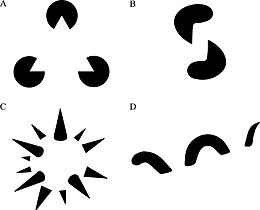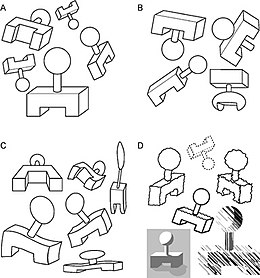
Emergence
Emergence is the process of complex pattern formation from simpler rules. It is demonstrated by the perception of the Dog Picture, which depicts a Dalmatian dog sniffing the ground in the shade of overhanging trees. The dog is not recognized by first identifying its parts (feet, ears, nose, tail, etc.), and then inferring the dog from those component parts. Instead, the dog is perceived as a whole, all at once. However, this is a description of what occurs in vision and not an explanation. Gestalt theory does not explain how the percept of a dog emerges.
Reification
Reification is the constructive or generative aspect of perception, by which the experienced percept contains more explicit spatial information than the sensory stimulus on which it is based.
For instance, a triangle will be perceived in picture A, although no triangle has actually been drawn. In pictures B and D the eye will recognize disparate shapes as "belonging" to a single shape, in C a complete three-dimensional shape is seen, where in actuality no such thing is drawn.
Reification can be explained by progress in the study of illusory contours, which are treated by the visual system as "real" contours.
Multistability
Multistability (or multistable perception) is the tendency of ambiguous perceptual experiences to pop back and forth unstably between two or more alternative interpretations. This is seen for example in the Necker cube, and in Rubin's Figure/Vase illusion shown here. Other examples include the 'three-pronged widget' and artist M. C. Escher's artwork and the appearance of flashing marquee lights moving first one direction and then suddenly the other. Again, Gestalt does not explain how images appear multistable, only that they do.
Invariance
Invariance is the property of perception whereby simple geometrical objects are recognized independent of rotation, translation, and scale; as well as several other variations such as elastic deformations, different lighting, and different component features. For example, the objects in A in the figure are all immediately recognized as the same basic shape, which are immediately distinguishable from the forms in B. They are even recognized despite perspective and elastic deformations as in C, and when depicted using different graphic elements as in D. Computational theories of vision, such as those by David Marr, have had more success in explaining how objects are classified.
Emergence, reification, multistability, and invariance are not necessarily separable modules to be modeled individually, but they could be different aspects of a single unified dynamic mechanism.[citation needed]
Prägnanz
The fundamental principle of gestalt perception is the law of prägnanz (German for pithiness) which says that we tend to order our experience in a manner that is regular, orderly, symmetric, and simple. Gestalt psychologists attempt to discover refinements of the law of prägnanz, and this involves writing down laws which hypothetically allow us to predict the interpretation of sensation, what are often called "gestalt laws".[2] These include:
- Law of Closure — The mind may experience elements it does not perceive through sensation, in order to complete a regular figure (that is, to increase regularity).
- Law of Similarity — The mind groups similar elements into collective entities or totalities. This similarity might depend on relationships of form, color, size, or brightness.
- Law of Proximity — Spatial or temporal proximity of elements may induce the mind to perceive a collective or totality.
- Law of Symmetry (Figure ground relationships)— Symmetrical images are perceived collectively, even in spite of distance.
- Law of Continuity — The mind continues visual, auditory, and kinetic patterns.
- Law of Common Fate — Elements with the same moving direction are perceived as a collective or unit.








No comments:
Post a Comment